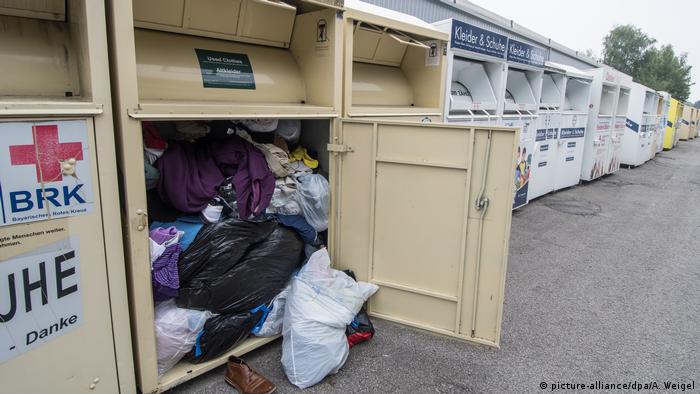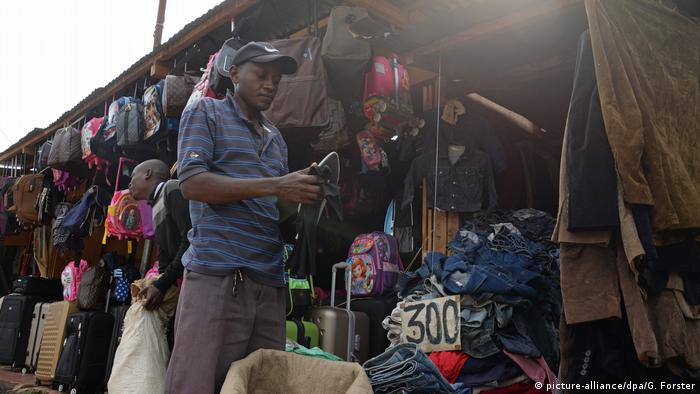What to do with the growing mountain of old clothes? Due to the fast-paced fashion trends, the industry complains about deteriorating quality of the cast pieces. The disposal may soon cost money.

Cluttered closets and full to the brim, chock-full of used clothing by Container: Around 5.2 billion of textiles the Germans have to be according to an estimate by the environmental organization Greenpeace in their closets, of which forty percent worn very rarely or never. The retail expert Thomas Harms of the consulting firm EY is even assumed that a large part of the garments that are bought, is no longer worn. “The textile industry has reached a turning point,” Greenpeace expert Viola Wohlgemuth.
Around a Million second-hand clothes are discarded per year in Germany – with increasing tendency. Greenpeace assumes that “significant quantities” of especially increasingly cheap purchased textiles just go in the trash. And collectors complain about the increasing share of textiles with poor quality in the not to use Used containers: clothing, the courses often already after a few washing. “About 50 percent of the things are no longer wearable,” says Thomas Ahlmann from the umbrella Association for fair rating, a coalition of over 130 non-profit used clothing collection organisations.
Dresses to rags
The collections given amounts in excess of the needs of charitable organizations for a long time “many times over”. Less than ten percent require the non-profit collectors, for their social work. The Surplus will be sold to commercial companies. With only about two to four percent of the votes cast, textiles account for only a tiny part of the things in commercial Second-hand Shops in Germany and Europe, sold.

The dress, the quantities exceed the requirements many times over – the quality decreases.
The majority of the still-wearable textiles are transferred to the customers in Eastern Europe, the Middle East, and Africa. The registry try the inferior textiles different reuse – for example, by this are processed into cleaning rags. “The mountain is so huge, that a recovery will be difficult,” said Ahlmann. Long ago, the disposal of low-quality textiles, had become a loss-making business that must be subsidized with income from the sale of the better pieces. In the industry will be discussed in the light of a rising proportion of low-quality textiles, as long as the disposal could still be offered free of charge, says Ahlmann.
Valve Africa
An important valve exports to Africa are currently. In Kenya, about the trade in old clothes is a great business. The capital, Nairobi, is littered with “Mitumba”markets. Stalls selling Jeans and sports shoes, T-Shirts and underwear are mainly sold to Europe and America. The people, the Thrift would like-goods, says Simon Kinyanjui, the offers on the Toi market in Nairobi, used clothing. Second-hand pieces from Europe and America would have better quality and are more durable than new clothing pieces that you get in Kenya, says the 37-Year-old.

Old clothes at a market in Kenya
The East African community (EAC) has announced that by 2019, but an import ban on used clothing. Although the countries are rowed in the meantime, a little back, especially on pressure from the United States. Uganda, Rwanda and Tanzania have increased their taxes on imported second-hand clothes, Kenya is holding back still.
Import bans on used clothing?
Proponents of import restrictions, there are many. “Such a ban would promote the local textile industry,” says the Deputy head of the Kenyan chamber of Commerce and industry, James Mureu. Although he sees that it initially would be difficult to meet the demand from the local production: “But necessity is the mother of invention.” Currently, only around 15 per cent of the EAC countries produced cotton would be processed locally, the Rest will be exported, says the East African Business Council. The Association is therefore in favour of the old clothes trade to gradually abolish.
Dealer Kinyanjui prepare such import restrictions. “It would be very bad. I can’t sell any new goods, I make hardly any profit,” he says. Also in Germany, the alarm bells to ring. A ban on imports of used clothes in Africa had, according to the assessment of Ahlmann impact on the industry, to a possible market crisis, “The camp would be full to run.”

